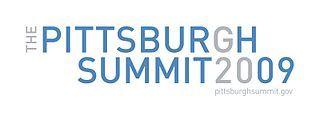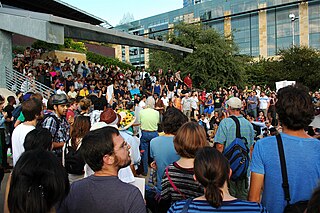The 1968 Democratic National Convention was held August 26–29 at the International Amphitheatre in Chicago, Illinois. As President Lyndon B. Johnson had announced he would not seek reelection, the purpose of the convention was to select a new presidential nominee to run as the Democratic Party's candidate for the office. The keynote speaker was Senator Daniel Inouye (D-Hawaii). Vice President Hubert H. Humphrey and Senator Edmund S. Muskie of Maine were nominated for President and Vice President, respectively.

Beginning in 2002, and continuing after the 2003 invasion of Iraq, large-scale protests against the Iraq War were held in many cities worldwide, often coordinated to occur simultaneously around the world. After the biggest series of demonstrations, on February 15, 2003, New York Times writer Patrick Tyler claimed that they showed that there were two superpowers on the planet: the United States and worldwide public opinion.

The 27th G8 summit was held in Genoa, Italy, on July 21–22, 2001 and is remembered as the peak of the worldwide antiglobalization movement as well as for human rights crimes against demonstrators.

The 3rd Summit of the Americas was a summit held in Quebec City, Quebec, Canada, on April 20–22, 2001.

The 28th G8 Summit was held in Kananaskis, Alberta, Canada, on June 26–27, 2002.
The 1971 May Day Protests were a series of large-scale civil disobedience actions in Washington, D.C., in protest against the Vietnam War. These began on May Day of that year, continued with similar intensity into the morning of May 3rd, then rapidly diminished through several following days.

The 33rd G8 summit was held at Kempinski Grand Hotel, 6–8 June 2007. The group of eight leaders met, while more than 100,000 citizens from around the world came to protest the undemocratic nature of the summit, and blocked the main entrance for three days. The summit took place in Heiligendamm in the old Duchy of Mecklenburg in the Northern German state of Mecklenburg-Vorpommern on the Baltic Coast. The locations of previous G8 summits to have been hosted by Germany include Bonn, Munich (1992) and Cologne (1999).

A demonstration is action by a mass group or collection of groups of people in favor of a political or other cause or people partaking in a protest against a cause of concern; it often consists of walking in a mass march formation and either beginning with or meeting at a designated endpoint, or rally, to hear speakers. It is different from mass meeting.

Kettling is a police tactic for controlling large crowds during demonstrations or protests. It involves the formation of large cordons of police officers who then move to contain a crowd within a limited area. Protesters are left only one choice of exit controlled by the police – or are completely prevented from leaving, with the effect of denying the protesters access to food, water and toilet facilities for a time period determined by the police forces.

The 2009 G20 London summit protests occurred in the days around the 2 April 2009 G20 London summit. The summit was the focus of protests from a number of groups over various long-standing and topical issues. These ranged from disquiet over economic policy, anger at the banking system and bankers' remuneration and bonuses, the continued war on terror and concerns over climate change.

The 2009 G20 Pittsburgh Summit was the third meeting of the G20 heads of state/heads of government to discuss financial markets and the world economy.
James Peck was an American activist who practiced nonviolent resistance during World War II and in the Civil Rights Movement. He is the only person who participated in both the Journey of Reconciliation (1947) and the first Freedom Ride of 1961, and has been called a white civil rights hero. Peck advocated nonviolent civil disobedience throughout his life, and was arrested more than 60 times between the 1930s and 1980s.
2010 G20 Toronto summit preparations had already begun in advance of the announcement of the meeting venue. Preparations for the important topics to be discussed at the summit evolved in tandem with practical planning for the meeting as a venue and as an event.

Occupy Seattle was a collaboration that has included direct action demonstration with occasional activity at Westlake Park and Seattle City Hall in downtown Seattle, Washington. Occupy Seattle was inspired by the Occupy Wall Street protests in New York City in September 2011, which in turn was inspired by the Arab Spring. The protest, like the one in New York, is against wealth inequality, perceived corporate greed, and corruption in the banking and economic systems in the United States.

Occupy Austin was a collaboration that began on October 6, 2011 at City Hall in Austin, Texas as an occupation and peaceful protest. It is affiliated with the Occupy Wall Street movement that began in New York City, and also with the "Occupy" protests in the United States and around the world. At the center of the occupation is the General Assembly, where the community comes out and tries to come to consensus on proposals for action.

The Occupy movement began in the United States initially with the Occupy Wall Street protests but spread to many other cities, both in the United States and worldwide. This list article is a summary of occupy events that have occurred in cities in the United States.
The 2001 meeting of the European Council was held in the Swedish city of Gothenburg, from 14–16 June.

















